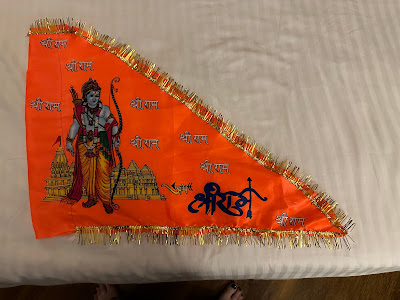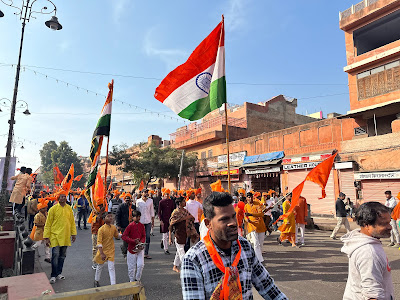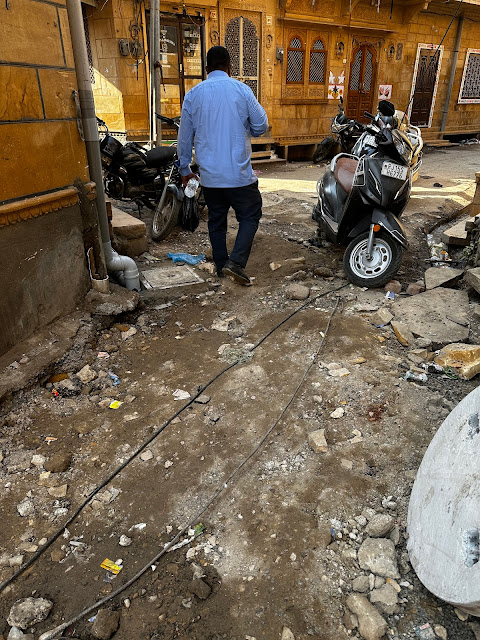Jaipur Day 2....Touring
Since I visited Jaipur last year, this year I needed to find some new stuff to do. My friend Jain had to return to his job in Jodhpur, so for this city I was back to being on my own. I met my guide in the lobby, as usual, then we drove off into the "pink city" as it's commonly referred to or the older part of Jaipur. How did it get this name? Well, in 1876 Maharaja Ram Singh had most of his city's building painted pink or what appears to me to be more of a brick color. At the time pink was known as the color of hospitality and since Queen Victoria was coming for a visit, he wanted to please her. England still had colonial rule over India and it remained that way until 1947. In my opinion the city walls look like giant pieces of gingerbread, but I'll let you decide for yourself.

People live inside and outside these walls. They are merely remnants from another time yet still striking. Another quick fact I learned on this trip is that in Rajasthan they still create many new buildings in this old style. Yes they have plenty of modern buildings as well, but it's great to see this beautiful technique is still created by hand today.
My half-day tour was meant to be spent visiting a neelgar to watch them work then create my own scarf. Instead another major event in India took place before I made it to my appointment. Ok, I need to hit you with some history so hold on to your butts!
In 1528 A.D. Babur, a Mughal ruler, whose origin trace back to the Mongols, invaded the Hindu city of Ayodhya. Babur was a Muslim ruler who embraced the Turkic and Persian cultures. Meaning the Turkic tribal peoples, not modern day Turkey and Persia which is modern day Iran. Anyway, he chose to demolish a Hindu temple dedicated to the god Ram and build a mosque devoted to Islam in its place. This is what conquers do. The last Mughal ruler of India remained in place until 1858 when the British East India company pushed him into exile. The British could have cared less whether a mosque or a temple remained on this site. So it persisted as it was until 1992 when angry Hindus tore it down. They wanted to rebuild their temple.
In 2019 the Indian courts decided to return this scared land back to the Hindu people since it is considered the birthplace of one of their primary deities Rama. Rama is the 7th avatar of Vishnu Brahman. Since there are like 3 million Hindu gods I'll just leave it at he's super important. Now typically I'm the first person to raise my hand and say "you can't give land back and reverse history" because in my opinion you can't. Look at Gaza and Israel. However, in this case the Hindu people allocated land so the Muslims could rebuild their mosque as well. Which I think is the right thing to do , but if you saw any of this on the news then you know you can't please everyone. So here I am on January 22, 2024 and India is ready to celebrate their new temple. And when India has a party the entire country has a party.
For days I had seen every home, building, shop, and bodega placing these orange flags everywhere. Being the American I am, I had no idea the temple was opening during my visit or how much one country can celebrate. As we drove through the gates of the pink city I saw a bunch of action going on. My guide said it was local celebrations for the new temple of Rama. Every local temple was having parades, parties, and fireworks, ALL NIGHT LONG. Seriously 24 hours of all three. The people of Jaipur are so warm and welcoming. They let me take tons of pictures and tried to get me to come along and celebrate.

The man above is wearing the traditional turban of Rajasthan.
The Rama Temple celebration flag.
Below: I believe they are dressed to represent the God Rama and his consort Sita.
After taking in the celebrations, my guide and I walked down a twisty alley to the home of a family of Neelgars. Traditionally within Indian history these were the people who were tasked with dying cotton the color indigo, which India is famous for and was very useful to Britain during their reign. However, now Neelgars do not just dye fabrics, but instead use a technique called baandhani or as we say "tie dye". Instead of rubber bands like we use in America, women will tie pieces of string to a fabric tightly. This is what keeps the dye from setting in certain areas. While this may sound simple I can promise you from watching this lady do it in front of me it was not. She was older than me, but she had arms of steal. She wrapped quickly and accurately not making one mistake. This is also a popular job for ladies since it can be done at their homes.

The next step is to apply the dye. This is typically done by the men since the work can sometimes be harder. They can apply one color or several depending on the style they want.
The scarf they made for me turned out white and orange although I wanted bright yellow. My husband upon seeing it asked me why I made a Whataburger scarf.....now I cannot unsee it. So, instead I purchased this turquoise scarf to wear. The pattern is traditional to the state of Rajasthan.
After my adventures in scarf making, my guide and I headed out to lunch. I was super excited when he suggested the same restaurant I ate at last year! Although I LOVE Indian food it's usually too spicy for me. Even when I say no spice at all it's still too hot. Yet, this one restaurant just gets me. They make the best chicken biryani that I can actually eat. I ate here two days in a row! After a great meal I headed back to my room to chill out before another busy day.
Finally, this was the sound coming into my room that night through closed windows. Fireworks were going off till I woke up in the morning.














No comments:
Post a Comment